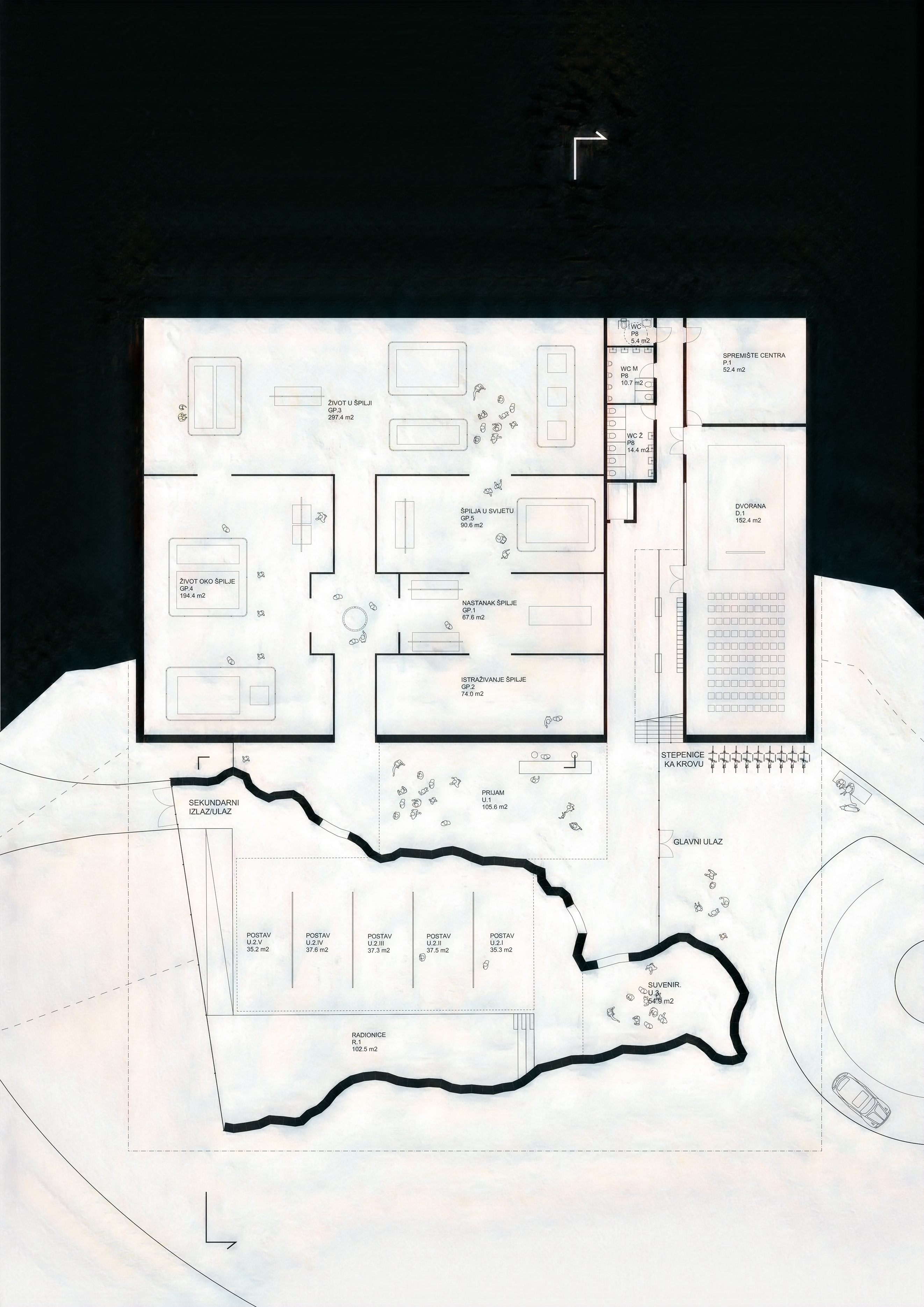#0249 Museum Center Vindija
Site
Donja Voca, Croatia
Planning / Realized
Competition (2025)
Client
Varazdin County
Size
2500 m2, museum with educational/research center
Team
Mirza Mujezinovic in collaboration with Naufumi Namba (Natowa) and Jonas Stokke (Jonas Stokke Design Office)
Site
Donja Voca, Croatia
Planning / Realized
Competition (2025)
Client
Varazdin County
Size
2500 m2, museum with educational/research center
Team
Mirza Mujezinovic in collaboration with Naufumi Namba (Natowa) and Jonas Stokke (Jonas Stokke Design Office)
Human beings strive for safety. Throughout history and prehistory, the Vindija cave functioned as a refuge. There, man ensured the existence of himself and his loved ones. The refuge belonged to both the individual and the community. It is a space where social relations and everyday needs were intertwined. It is the embryo of today's settlements and squares. As such, it is one of the oldest public spaces not only in Croatia, but also in Europe, and the world.
Our intervention is based on the idea of a refuge as a public space. The interpretation center is conceived as a meeting point that belongs to the local community of Donje Voće, and to tourists and scientists, both domestic and foreign. The building is "built" into the terrain as a landscape element where the roof becomes a new public space - a local square that connects to the existing terrain. Being on a roof terrace with a view of the landscape and knowing that right below is a vault of historical and prehistoric artifacts, is one way to be aware of one's short-lived existence, but still long-lived in a biological-social sense. Humankind has been present in this area since ancient times. From prehistoric times to the present, the outlines of the landscape are the same, the topographic vistas are still present, the movement of the sun is identical. The roof terrace functions as a link between something long gone and something modern, something underground and something natural and everyday.
All the outdoor facilities provided for in the project program are designed to be located on the roof (children's playground, stargazing areas, local performances, presentations, a toilet). Imagine spring masquerades on the roof of the interpretation center! The main facilities of the center are located under the roof: the entrance with reception and the educational-tourist display, the main display, a multi-purpose hall and a space for workshops. On the first floor, with access to the roof terrace, are the rest of the facilities (cafe, laboratories, residential accommodation and staff offices).
The guiding principle of the architectural concept is the desire to recreate the cave in its true size and position in the landscape. The orientation of the opening is to the south. This would allow visitors to experience its true size, spatial diversity and relationship to the movement of the sun. We approach the Vindija cave as an objet trouvé, where we use its simplified three-dimensional form as the basis for the architectural design of the center. The natural-geological form contains diverse and unusual spatial situations. The educational-tourist content (exhibition in the entrance area), workshops and souvenir shop are located inside the new cave, which functions as a living room. The entrance and reception to the interpretation center is outside it. From the moment they enter the center, visitors will get the impression of what it is like to be in the cave and outside it, or what it is like to be in the refuge and outside it. "
Our intervention is based on the idea of a refuge as a public space. The interpretation center is conceived as a meeting point that belongs to the local community of Donje Voće, and to tourists and scientists, both domestic and foreign. The building is "built" into the terrain as a landscape element where the roof becomes a new public space - a local square that connects to the existing terrain. Being on a roof terrace with a view of the landscape and knowing that right below is a vault of historical and prehistoric artifacts, is one way to be aware of one's short-lived existence, but still long-lived in a biological-social sense. Humankind has been present in this area since ancient times. From prehistoric times to the present, the outlines of the landscape are the same, the topographic vistas are still present, the movement of the sun is identical. The roof terrace functions as a link between something long gone and something modern, something underground and something natural and everyday.
All the outdoor facilities provided for in the project program are designed to be located on the roof (children's playground, stargazing areas, local performances, presentations, a toilet). Imagine spring masquerades on the roof of the interpretation center! The main facilities of the center are located under the roof: the entrance with reception and the educational-tourist display, the main display, a multi-purpose hall and a space for workshops. On the first floor, with access to the roof terrace, are the rest of the facilities (cafe, laboratories, residential accommodation and staff offices).
The guiding principle of the architectural concept is the desire to recreate the cave in its true size and position in the landscape. The orientation of the opening is to the south. This would allow visitors to experience its true size, spatial diversity and relationship to the movement of the sun. We approach the Vindija cave as an objet trouvé, where we use its simplified three-dimensional form as the basis for the architectural design of the center. The natural-geological form contains diverse and unusual spatial situations. The educational-tourist content (exhibition in the entrance area), workshops and souvenir shop are located inside the new cave, which functions as a living room. The entrance and reception to the interpretation center is outside it. From the moment they enter the center, visitors will get the impression of what it is like to be in the cave and outside it, or what it is like to be in the refuge and outside it. "






